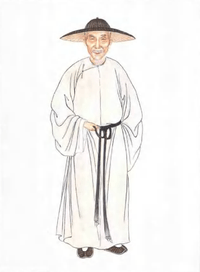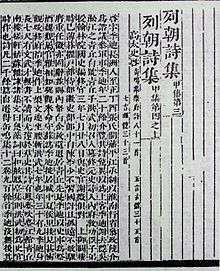Qian Qianyi

Qian Qianyi (simplified Chinese: 钱谦益; traditional Chinese: 銭謙益; pinyin: Qián Qiānyì; Wade–Giles: Ch'ien Ch'ien-i; Suzhou dialect: [zi tɕʰi ɪʔ]; 1582–1664) was a Chinese official, scholar and social historian of the late Ming Dynasty.[1] Qian was a famous author and poet; and along with Gong Dingzi and Wu Weiye was known as one of the Three Masters of Jiangdong.[2]
Biography
Qian was born in Changshu county of Suzhou prefecture (now in Jiangsu province). His courtesy name was "Shouzhi" (受之) and his pseudonyms were "Muzhai" (牧斋) and later "Mengsou" (蒙叟).[1] He passed the imperial examination in 1610 at the age of 28.
Qian knew many independent women from entertainment and artistic circles, whom he treated as equals. One was a Ma Ruyu from Nanking, a consummate actress. She had had a good formal education. In addition she could paint and produce calligraphy in the square style. In her time she intimidated the male literati around her. Like many others of her kind, she abandoned her stage life and took up religion, building a Buddhist retreat. Another was Liu Rushi (1618–1684), who became his consort after he was impressed by her accomplishments. He treated her as his intellectual equal and companion on travels and social gatherings. Her poetry was preserved by Qian. Qian had important ties to the local writers and artists in the Jiading and Kunshan area outside modern Shanghai.
Preceding this generation of individuals was the prose master Gui Youguang (1507–1571) who opposed the classicists headed by Wang Shizhen (1526–1590). The antagonism to the classicist school would continue throughout the life and writings of Qian Qianyi himself.
In 1644, Qian taught an excellent student in Nanjing: Koxinga.
Works

His principal work and contribution to period history was the Liechao shiji 列朝詩集 (Lieh-ch'ao shih-chi),[1] originally a lengthy anthology of poetry with attached biographies. At present the biographies alone are printed and the work has become an unmatched history of individuals from the middle and lower strata of 16th- and 17th-century Chinese society. His father gave him special instruction in historic classics. Qian showed an early interest in the classic Shishuo xinyu, a work of historical anecdotes. Like Qian Qianyi himself, others of his circle were closely involved in education and the revival of the study of antiquity as the basis of learning. Qian's Liechao shiji was published by his associate and printer Mao Jin, who like Qian himself, showed a concern for poorer scholars. Mao used money from his printing for charitable work and needy scholars.
Notes
References
- Carpenter, Bruce E., "Ch'ien Ch'ien-i and Social History", Tezukayama University Review (Tezukayama daigaku ronshū, Nara, Japan, 1987, no. 58, pp. 101–113. ISSN 0385-7743
- Ci hai bian ji wei yuan hui (辞海编辑委员会). Ci hai (辞海). Shanghai: Shanghai ci shu chu ban she (上海辞书出版社), 1979.
- Goodrich and Yang in Hummel, Arthur W., Eminent Chinese of the Ch'ing Period, Washington, 1943, pp. 148–150.
- Zhang, Hongsheng (2002). "Gong Dingzi and the Courtesan Gu Mei: Their Romance and the Revival of the Song Lyric in the Ming-Qing Transition", in Hsiang Lectures on Chinese Poetry, Volume 2, Grace S. Fong, editor. (Montreal: Center for East Asian Research, McGill University).
Further reading
- Lawrence C.H Yim (2009). The Poet-historian Qian Qianyi. Routledge. ISBN 978-1-134-00606-9.